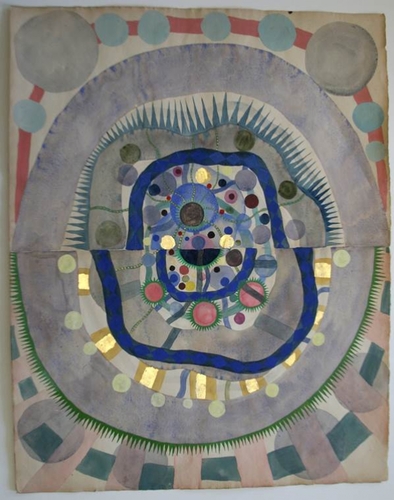BRATTLEBORO — In a hodge-podge of books and objects left behind in the 1911 home in Marlboro where she moved with her family four years ago, Julia Zanes found a remarkable old book, Gondola Days by F. Hopkinson Smith.
“Published in 1897, Gondola Days is an account of Smith's travels to Venice,” says Zanes. “It turns out that F. Hopkinson Smith was quite an accomplished man. He built the foundation of the Statue of Liberty and was also a writer, artist, and engineer. Gondola Days may not have been a real page-turner, but the language is splendid.”
The topic of Smith's book appealed to Zanes because Venice has long been one of her favorite places. She met her husband, artist and musician Donald Saaf, when both worked as security guards at the Isabella Stewart Gardner Museum in Boston, which Zanes calls a “little microcosm of Venice.”
Gondola Days inspired Zanes to create So like a mirror is the sea/So vast the vault above, a collection of works on papers and poems that incorporate text from Smith's book.
This exhibition opens at The Emblem Museum, a new museum on Elliot Street in Brattleboro, on Saturday, March 4, with a reception with live music from 2 to 6 p.m., and will be open to the public until Saturday, April 22.
'Illuminated manuscripts'
To create the exhibition, Zanes cut words directly from her copy of Gondola Days and incorporated them into her paintings.
According to Zanes, Smith's text became one “ingredient” in the whole. “The rest of the recipe was antique paper, gold, watercolors and gouache.”
Zanes characterizes what she created as mixed-media works-on-paper, or better still, “illuminated manuscripts,” which traditionally supplement texts with such decoration as initials, borders, and miniature illustrations.
Furthermore, Zanes also believes that her re-arrangement of Smith's words could be characterized as poems that were “written” by assembling whole sentences and sometimes words or letters.
Zanes has lived and worked in southern Vermont for over two decades. Educated at The School of The Art Institute, Chicago, she and her husband teach at The Putney School. Zanes has presented her work throughout New England, as well as in Canada, New Orleans, and Chicago. She has been exhibiting with the Clark Gallery in Lincoln, Mass., since 1991.
“I started being an artist as a child,” Zanes says. “For the past 30 years making art has been my life. I work all the time. I really don't know how many pieces I have created.”
Zanes often uses rich, deeply researched source material, such as fairy tales, fables, and other historic narratives, as inspiration or as media that are directly collaged or integrated into her work.
“I am very much driven by stories to create the work I do,” she says.
Zanes explains in more detail at her website, www.juliazanes.com: “Many of my paintings involve narrative. If there is any one tendency that runs through all experiences in life, whether waking or dreaming, it is the will to narrate. To tell the story is part of the mind's process. Sometimes the stories we create have a linear quality, at other times they emerge almost as a riddle. But, always, there is story.”
Meaning and mystery
Even though several years ago Zanes' work became more abstract, she contends that everything is still based on what she calls “narratives in my head.”
“Through color, collage, the interplay of deep and flattened space, pictorial devices associated with a figurative tradition, and more, I attempt to go into those moments between sense and non-sense, when storytelling is at its most urgent,” she writes.
“And while the aim is to create work that has that 'fated' effect, I always strive to expose the process of narrative, of meaning-making that leads up to it. There is chance, there are mistakes and experimentation, but, in the end, I would love for the result to be that it appears as if 'everything is fated,' even as the mystery of what precedes that fated effect remains with the viewer.”
Perhaps it was fate that led Zanes to Gondola Days and her new show.
Although her only connection may have been a discarded book in her new home, Zanes feels that in So like a mirror is the sea/So vast the vault above, she had been actively collaborating with a man she never met and who had been long dead - F. Hopkinson Smith.
“Smith really embodies the spirit of the American art plunderer, rather like Isabella Stewart Gardner, whose museum I used to work at a long time ago,” Zanes says. “Smith's book on Venice is written with that attitude.
“But I really can't act all that superior to him since here I am plundering his work for this show. That Smith created the base of the Statue of Liberty somehow seem pertinent to our world today. We all are involved in this together. You see, I like to connect the dots.”
